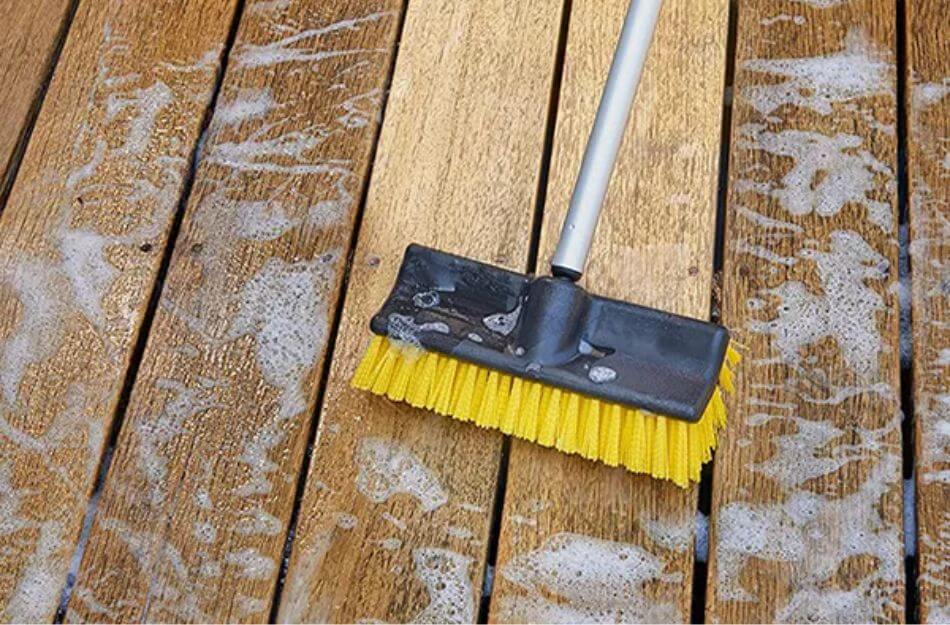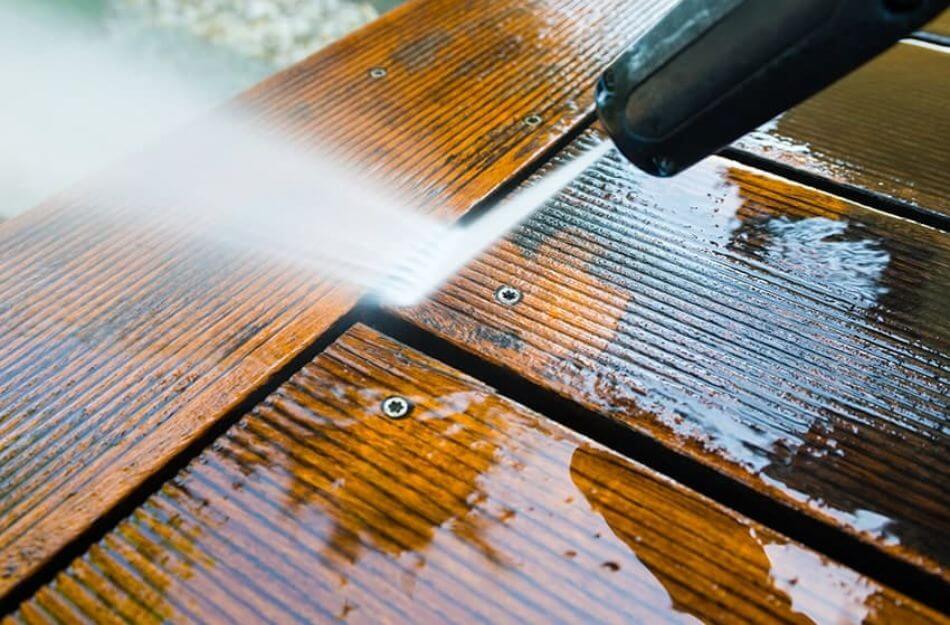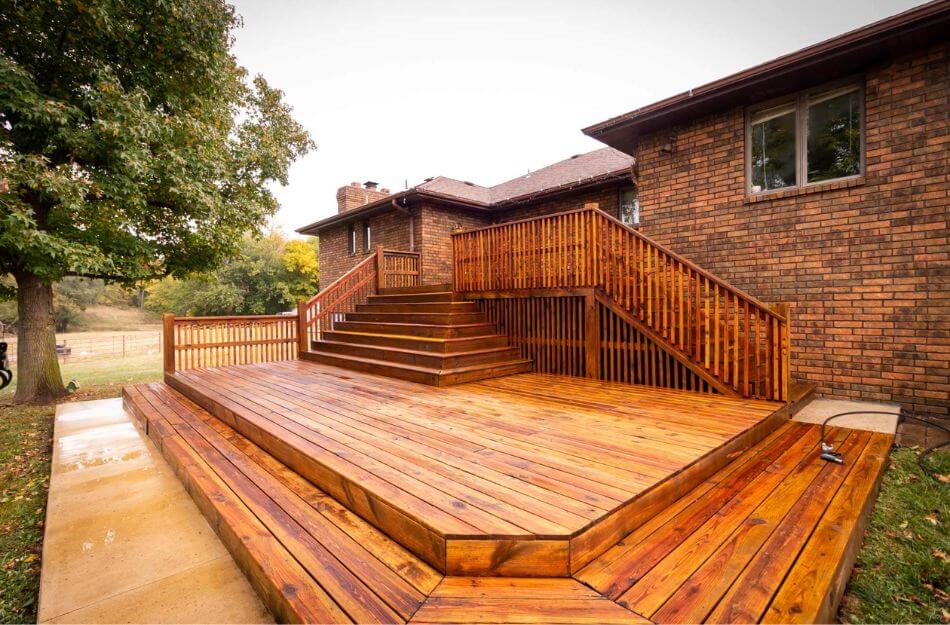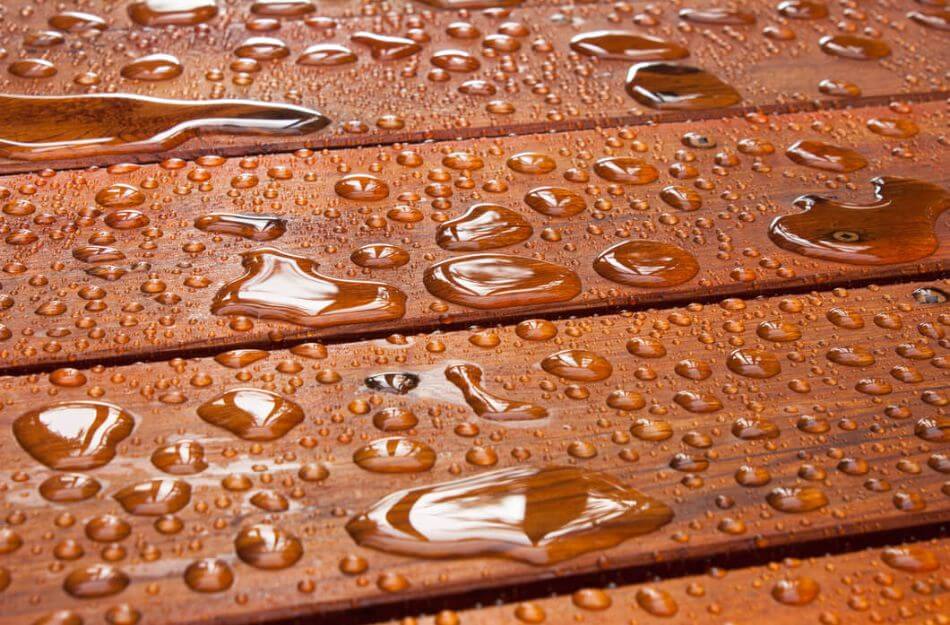Although deck sealing may not be at the top of your summer to-do list, you shouldn’t put off a task.
One such deck that channels the opposite of the lively and enjoyable vibe you want from an outside (and properly sealed) deck is the grey, weathered deck with an old appearance that we have all seen.
Although the look of worn wood has its place, a sun-beaten deck can significantly lower your house’s curb appeal.
Deck staining is a DIY or professional activity that may be completed over the weekend.
However, the question of how long the stain must dry before it can be safely exposed to rain frequently arises among homeowners who want to do it themselves.
Regarding DIY options, experts advise you to wait 30 days before sealing your deck. The precise response will depend on several variables, including the kind of deck stain you select and the weather when you stain your deck.

Wood, whether hardwood, pressure-treated, or cedar, is the most widely utilized material for decks, according to most contractors and homeowners.
Wood is visually beautiful, strong, simple to maintain, and affordable. Staining your deck, however, could be a smart move to maintain it in top shape longer and safeguard it from the elements.
By maintaining your deck correctly sealed, you may avoid the ugly appearance and significant risk that come with a worn deck.
Deck sealing is surprisingly easy to do yourself, though it does need some elbow grease.
Plus, all that effort will have been more than worthwhile once you see the sheen and glow of a professionally sealed wood deck.
Please continue reading to learn everything you need to know about sealing a deck, including how to do it, what kinds of stains and sealants to use, and when it’s best.
Table of Contents
- 1 Sealing Overview
- 2 How Long Does It Take To Seal A Deck?
- 3 How to Seal a Deck?
- 4 Deck Sealing Tips and Tricks
- 5 Best Benefits to Sealing Your Deck
- 6 Dos and Don’ts of Sealing the Deck
- 7 Staining vs. Sealing
- 8 How Much Deck Sealing Costs?
- 9 When Is A Good Time To Seal My Newly Constructed Deck?
- 10 Final Words
Sealing Overview
Decks are sealed to keep water from permeating the wood’s surface; most sealants now incorporate UV protection to help protect the wood’s integrity from UV deterioration.
With frequent application, sealing can help the wood retain its natural appearance for many years.
The fact that deck sealants are wax-based is a drawback. It creates a layer of protection that keeps water out while also causing the water to bead up and not drain away.
Because of the protectant, some decks may have standing water for days after a hard storm. Every year, the protector must be reduced to maintain the protection.
How Long Does It Take To Seal A Deck?
Some sealants can be applied directly to a wet deck, while others need the surface to have dried for at least 48 hours after washing.
Becoming familiar with the product is crucial, To comprehending the time commitment. After applying almost all sealants, you must wait for dry weather to pass, so check the forecast before you begin.
Ensure no one (including dogs) steps on the deck while it is drying.
The time it takes to complete this project will be significantly longer if your deck is in bad condition and requires significant cleaning or repairs before it can be sealed.
You want your deck to be in good shape before you seal it. The sealant you select will largely determine how long it takes to seal a deck and how much it will cost.
Pay special attention to the manufacturer’s application directions when looking for deck sealants.
How to Seal a Deck?
Cleaning a deck is the first step in sealing it. Pressure washing the surface is the quickest approach to removing the filth and that aged, dull layer off your deck.
For directions on how far the wand should be from the surface, use a fan tip and refer to the pressure washer manual. The wood won’t get gouged as a result of this.
After the deck has dried, check for any damaged or loose boards that require repair. Replace damaged planks and firmly fasten loose boards.
Additionally, this is an excellent time to fix any squeaky boards, take care of any other deck issues, or even sand your deck.
Apply your staining sealant next as directed by the manufacturer. Cover all corners and joints to ensure that the sealant penetrates the entire surface.
Before using the deck, allow it to dry for at least 48 hours. To get the best results, refer to your deck sealant’s humidity and temperature guidelines and plan accordingly.
Deck Sealing Tips and Tricks
Deck sealing is important for deck maintenance, and that’s why knowing the tips and tricks for sealing might help you do your task easily.
You can improve your deck sealing in a few straightforward ways.
Deck Sanding
While using a pole sander to sand your deck is optional, it will enhance the appearance of the wood and promote deeper sealant penetration.

It only needs a fast pass with 120-grit sandpaper before sealing. When finished, sweep away all dust and debris with a leaf blower.
Scrub the Deck Well
After pressure washing the deck, use an all-in-one cleaner to clean further and shine the wood. While you should always consult your cleaner for application instructions, a pump sprayer works best for most cleansers.

For dilution specifications and safety precautions, refer to the manufacturer’s instructions. After using a garden hose to remove the cleaner, give the deck 48 hours, or however long the cleaner recommends to completely dry.
Destroy Stubborn Stains
Tough stains might linger even after pressure washing and using deck cleaning. Use non-chlorine bleach to get rid of them. Apply the bleach, scrub with a hard brush, and thoroughly rinse with water.

Timely Reseal
Even the top deck sealants only last for a while. When your deck has been sealed, read the directions for resealing and mark the date on your calendar. The best approach to safeguard your deck is to reseal regularly.
Best Benefits to Sealing Your Deck
Deck sealing has numerous benefits as it helps to protect your deck from weather exposure, mold, and pest, providing a pleasant look, etc. If you are confused about whether to seal your deck then read these benefits mentioned below to clear our confusion.
Painting, staining, and sealing are the three basic options available to deck owners. And while all three have virtues, sealing has particular advantages you should be aware of before choosing.
Only sealing preserves the beauty of the wood, and even dyes slightly change the color of the wood, so this claim is not exaggerated.
Stains can help retain the wood’s inherent grain pattern but will still make the wood appear darker. A clear stain is the greatest option if you adore the deck wood’s original grain pattern and color.
Sealing Adds a Beautiful Sheen
Sealants come in a huge variety, which is fantastic. You can get an essentially invisible sealant. However, you want to increase the impact of your deck without affecting the wood’s inherent beauty. In that case, you can purchase a seal that gives the wood a fashionable sheen.

Sealing Prevents Moisture
Deck sealants get deep inside the wood to help the planks stay waterproof. They also produce a layer on the surface to prevent water from penetrating the wood.

This dual-action defense is excellent for avoiding mold, mildew, wood rot, and fungal growth, all of which can harm your deck.
Sealing is Economical
If you decide to do the process yourself, sealing is one of the most economical ways to finish your deck.
Compared with staining and other paints, it is still one of the least expensive solutions, especially if you hire a contractor.
Your wood can be saved by sealing. Painting and staining don’t provide the same level of protection as sealing. We frequently advise sealing as the finishing touch when repairing an old, damaged deck since it will save weak timber from suffering additional harm.
Sealers and Stains Can Be Used Together
Many people prefer that stains give their deck color and that the additional pigmentation shields it from UV rays.
But other than UV prevention, the stain doesn’t offer much else in the way of deck defense. However, you can use a pigmented mixture sealer for all-around weather, water, and UV protection.
Dos and Don’ts of Sealing the Deck
Protecting your deck from the elements is one of the best methods to increase its lifespan. By avoiding these frequent sealing errors, you can keep it in good condition for a long time.
Sealing a wooden deck is not a challenging Do It Yourself task for a homeowner.
The first step to achieving quality outcomes is selecting the proper sealant for your deck. Once you have the product, use our professional advice for sealing a deck to complete the task successfully.
- Don’t seal a new deck for 30 days. If you recently constructed a deck, you can’t wait to seal it off and complete it. However, wood preservers frequently need around 30 days to dwell before the deck can absorb the sealer. Pour some water on your deck once 30 days have passed. It is still too moist to seal the wood if it beads up. It is prepared to seal if the water has been absorbed. Once the wood is prepared, make sure you seal it right away. The longer the deck is exposed, the higher the risk of moisture and ultraviolet (UV) damage.
- Keep paint, stain, and sealer separate. A deck can be painted, stained, or sealed for varying levels of protection. The main purpose of sealants is to guard against moisture-related harm. They are thicker viscous than stains and feature waterproof or water-repellant qualities. Although they exist, finding a clear deck sealer with UV protection is uncommon. It is because, in contrast to stains, sealants frequently lack the pigmentation necessary to block UV rays naturally.
- Stains are always pigmented, giving the deck color and offering UV protection. Even the best deck stains often only provide limited moisture protection, but even this is still preferable to no protection. The best deck paint typically lasts only briefly as a sealer or stain. However, the paint may safeguard against UV and moisture damage, whether latex- or oil-based. Another thing to be aware of with deck paint is that it can bubble and chip if there is any residual moisture in the wood at the time of application.
- Before applying sealant, repair, clean, and sand your deck. The key to good deck sealing is proper preparation. Start by tightening or replacing any shaky or damaged boards. After that, scrub the surface clean with a power washer. After giving the deck 24 hours to dry, use a sanding disk or 60–150 grit sandpaper to smooth the surface. Use a powered sanding tool to remove the top layer of wood, which can serve as a barrier to the sealant. Suppose your deck has old sealant on it. In that case, it’s crucial to thoroughly sand the surface, paying attention to the parts where the sealant has worn away and where moisture protection is still present. Sand the surface evenly to achieve a clear, naked surface since any remaining areas of the old sealant will hinder the new sealant from being absorbed. Finally, give the wood a thorough sweep or vacuum. A brand-new deck would require at least a quick washing and drying to remove any dirt and grime developed over the initial 30-day drying period.
- Deck sealer should not be applied to wet or icy surfaces. When the sealant is applied to a damp or icy deck, the result will be, at best, an uneven, splotchy finish that will only adequately preserve your deck. In the worst case scenario, the sealant will fail to be absorbed and instead bead up on the water, posing a filthy and hazardous slipping hazard. After a rainstorm, the deck’sdeck’s surface should always dry for at least 24 hours. Then, before sealing the deck, ensure the surface is prepared to absorb the sealer.
- Only seal a deck with the correct equipment and methods. You can use a roller, a paintbrush, or even a paint sprayer to apply deck sealer. We advise wearing knee pads if you work on your hands and knees. You can also use an extension pole to work from a standing posture. Proceed slowly and deliberately to guarantee proper covering of every square inch of the deck. Applying more than one sealant application at once increases the risk of peeling and chipping because it oversaturates the surface. Most of the time, one coat will be sufficient; however, if you prefer to add another, waits at least 24 hours before doing so.
- The weather and time of day should not be ignored. Schedule sealing your deck when the outside temperature and period of day are ideal. Ideally, you want a day that is between fifty and ninety degrees Fahrenheit, nice, and not too windy. Arrive at work early because a July afternoon’s bright sun can cause the sealant to dissipate quickly and impair its absorption ability.
- Remember to stain and protect your wood once a year. Depending on your temperature zone and the age of your deck, using a good deck stain and sealant at least every year is a smart idea. In areas with more sunlight, firmly follow a once-per-year schedule to shield the wood from damaging UV rays. Sealing and painting every two to three years would be acceptable in the north. However, remember that decks in these areas are more prone to moisture damage. Residents in the north should carefully sand the deck before sealing it. Ensure the sealer penetrates the wood and offers an enduring defense against snowfall and other moisture-related damage.
- 48 hours after applying a wood sealer, don’t utilize the deck. While wood sealant often dries to the touch in a few hours, you should avoid using your deck for two full days to ensure a thorough seal that safeguards the wood. The effectiveness of the seal can be impacted by interfering with the drying process, and you might end up having to seal the wood again.
- Before sealing, do cover plants and seal off your siding. It’s good to shield plants from contamination when using chemicals nearby. The function of a deck sealant is to serve as a moisture barrier for timber, and it will also do the same for plants. A plant may not be able to absorb the nutrients it requires if the sealant is being dropped on it. It might get spots and eventually pass away. Use plastic sheeting or drop cloths to cover the plants close to the deck while applying the sealant. Cover the door trim, roofing, and thresholds inside the house with painter’s tape, cardboard, and drop cloths.
- Using stickier tape than a painter’s should be avoided as it may cause surfaces’ finishes to flake off.
- A deck should never be resealed hastily. Cutting corners won’t help you do a task well, even if they help you finish it quickly. You risk having a finished deck with uneven color if you neglect washing and to fix it before sealing. If particles are on top of the wood, the sealer cannot adhere to the wood and will instead adhere to the particles. Another quick fix is to apply sealers too thickly. It may take longer for the sealer to absorb, resulting in uneven drying and discoloration.
- By ignoring dry periods and acting as though the deck isn’t still too sticky to walk on, don’t attempt to hasten the job. You have to start the entire procedure over if you walk on a deck before it is completely dry.
- Do fully whisk the deck sealant before using it. When applying fresh paint, stain, or sealant, “shake or stir?” is frequently posed. It’s a sure bet that the solution is to stir rather than shake, at least regarding deck sealers. A sealer can bubble when shaken, and the bubbles will be visible on the deck’s surface. The manufacturer’s instructions for stirring, trembling, drying durations, and other factors should be apparent on the can’s label. Therefore it is best practice to read it before applying a sealant. To read the directions more clearly, if the type on the label is too small, take a picture of it and enlarge it.
Staining vs. Sealing
Although they are sometimes used interchangeably, sealer and stain have distinct characteristics. The pigment’s existence makes a noticeable visual change.
Stain always contains pigment, whereas sealant occasionally contains pigment that will color the wood when applied.

Additionally, the two products’ levels of protection differ. While sealer provides excellent moisture protection, stain offers little to none.
On the other hand, transparent sealants provide little to no UV protection. In contrast, many stains’ pigments can serve as a UV barrier for the wood.
It would help if you first stained your deck before sealing it with a clear sealer to protect it from moisture and sun damage.
After the required preparation work, you may discover products combining stain and sealer to create comprehensive deck protection in a one-step application method.
Refer to the manufacturer’s application guidelines after choosing staining sealants that protect against UV and moisture.
How Much Deck Sealing Costs?
Although your actual cost will vary depending on your place of residence, the dimensions and state of your deck, and other considerations, the typical cost to have your deck sealed by a professional is roughly $900.
According to professionals, handling this task on your own will save you 50% to 75% of the overall cost, making sealing your deck a reasonably cost-effective method to improve the appearance of your home and safeguard your deck investment.
The size of your deck and the type of materials you use will affect the cost of the components.
We advise avoiding cheap deck sealants in favor of better-quality alternatives because they often provide better and more durable protection.
When Is A Good Time To Seal My Newly Constructed Deck?
It is a good time If the temperature is over 40 degrees. Any time of year, even in the winter, you can seal decks if it gets warm enough for a few days.
Since people spend more time on their decks throughout the summer, it is a busy time for many people.
Final Words
Decks are a lovely improvement to any house. In addition to helping you make the most of your outdoor space, they also raise the value of your house.
Long-term neglect of your deck will result in an expensive home remodeling project. Maintaining your deck will increase its lifespan to 25 years or more.
If you don’t maintain your deck, broken or fragmented wood, fading stains, and other wear-and-tear problems can occur.
You can identify problems as they arise if you know how to clean your deck before restaining it.
Most wood sealers require 24 hours to dry before being ready, but many experts advise waiting 72 hours before using the deck.
Make sure there is no rain in the forecast and that temperatures will be warm enough for it to completely dry by checking the weather before you begin.
Now that we’ve covered everything there is to know about sealing, we hope you can grasp the article. To assist your friends in this process, forward this information to them.
Recent Posts
Any home would benefit from having a deck because it adds more area for socializing, relaxing, and outside activities.Garden decking that has been properly polished can be elegant and lovely. It...
It's time for spring cleaning, and while many homeowners focus on the scratched baseboards, the dust bunnies, and the smudged picture frames around the house, it is important to remember the deck....
